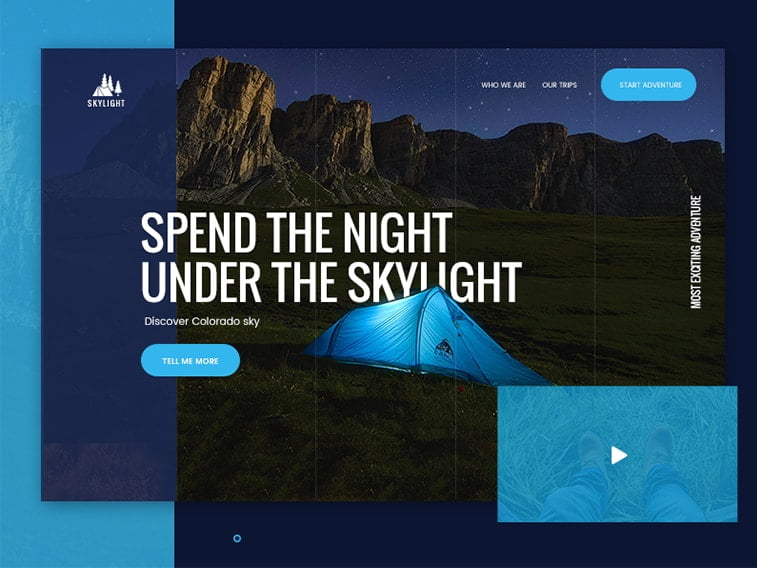Having a strong online presence has become somewhat like rocket-science. There are so many factors to keep in mind and so many parameters to fine-tune that business owners might even often think that growing a digital blooming ecosystem from the ground up is impossible without a huge budget and the best marketing tactics and experts.
Well, it’s somewhat true that breaking the ice in the digital realm will require time and money to be spent. However, there will always be a few simple and effective ground rules that will set you up the right way and will enable you to expand your presence and your business along the way.
That being said, people oftentimes tend to overlook a few basic things. Such things are UI and UX and the difference they can make to your business and online efforts in the long run.
Playing the UX/UI cards right
Nowadays, UX and UI, for the most part, play a crucial factor in a mobile or web application’s success. These are the main differentiators, even more so than code and other equally paramount steps in web development.
How?
In the earlier years of web dev, for the most part, the challenges were more of a structural nature. The technology behind the back-end was primitive just like browsers. In such a setting, the true challenge was getting the app to work properly.
Today, making things work as they should is a lot less difficult because both the browsers and the web frameworks (both front- and back-end) have become more sophisticated.
Such technological shifts and web design trends have revolutionized not only how developers and designers work, making their job more streamlined, and more exploratory, but it also managed to create many changes in user behavior and overall user experience.
And these latter changes are those that are influenced by good (or bad) UI and UX practices the most, ultimately leading to the success or downfall of an app, web page, or online service.
So, what are the basic things you need to prioritize first and foremost? Let’s go over each of them.
UX and UI as development priorities
What makes great UX/UI Design practices:
Alignment
This one shouldn’t come as anything too scientific, even though there are cases when page owners and web designers alike want something truly unique and exciting and lose track of what will really make the page or app work.
Alignment is one of those things. Titles, images, paragraphs should be all aligned on your site, following a consistent and predictable flow. This might come off as a no-brainer, as a page with proper alignment is easy to follow, easy to read, to consume.
White space
This one is also pretty much self-explanatory. If you run a pretty hefty app, chances are, you will have different paragraphs, images, titles, different elements, tables, videos, lists, and clickable buttons on your pages.
In order to make them stand out and create a sense of harmony between all these elements, you need white space or breathing space. This way, all the content and the CTAs on your website will be more visible and distinctive on your pages and won’t be overcrowded and squished.
Have more of a minimalistic approach instead of cramping everything on a single page without any room left. You need to have some structure on your web app, and you want your users to notice some of the most important elements of your page (let’s say, a CTA button).
Font use
There are basic rules you should take into consideration whenever you are choosing a font. First of all, you would want to go with a type of typography that’s representative of your brand, page, and/or type of content you are pushing. Look at it this way. If you are working on a site that sells dental supplies, you probably won’t be choosing a goth-style font for the content or to schedule a call. Instead, you will probably want a more subtle touch to it, something more formal that complements the nature of your brand and content.
At the same time, you don’t necessarily have to stick to one single font, however, using more than two on a single page can get things pretty messy pretty quick. If you want to experiment, you definitely can, however, always look for fonts that are more or less similar in style, so you don’t get the user too overwhelmed.
Colors
When speaking about mixing and matching colors, the same analogy could be applied as with fonts. While it’s always good to experiment and to try out exciting matches, always remember the main project you’re working on. If you are designing a website for an attorney, you probably shouldn’t look for inspiration on kid’s websites. Always try to complement the theme, the main idea, and the feel of the website/business/brand.
Mixing and matching should also be approached in a similar fashion. Colors can either complement each other or clash, based on the overall feel you’re after, but generally, they shouldn’t draw away the users’ attention from the content.
On the other hand, if you use your color patterns with a purpose, as a branding or marketing element, you can go one step further. When there’s a call for it, you can freely experiment with putting your colors at the forefront, however, in most cases, they more or less remain a supporting element.
Psychological UX
User experience or good user experience means how easy your site (or app) is to use. This has less to do with feel and overall looks, but practicality. It’s safe to say that UI will be the main factor that will grab your users’ attention but good UX features will be those things that keep them on your website.
Ebony and ivory
Good UI and UX shouldn’t be a priority, they should be a hand-in-hand feature, that seamlessly connects aesthetics with practicality.
To put it in simpler terms, your users won’t stay on the website for long if it doesn’t have those eye-pleasing features, such as white space, alignment, coherent color, and font use. However, no matter how good-looking your web app is – if it’s not intuitive to use and/or it’s navigation is off – your chances of people revisiting your site or actually performing an action on it, are pretty slim.

Also, in some cases, good UX can be enough. Look at Google.com. You can’t really say that it’s a beautiful website, but can it handle well and easily? You bet.
UX and UI as marketing factors
Sometimes it just takes a little extra thinking to make it painstakingly obvious that UX and UI will help you with your marketing efforts. Here are just a few instances when they can help you achieve your marketing goals:
They help with building brand trust
Building trust is an intricate and complex process that requires almost all of your online and offline processes to be streamlined and optimized. From working with the best shipping options, providing impeccable customer service, offering competitive prices, using the right fonts, and having the best site navigation, every little piece of the puzzle needs to fit perfectly to increase your reputation and the trust your customers have in you.
Think about it this way: if you’re running an eCommerce website, your low prices and fast shipping won’t be your main selling points if your customers are having a hard time finding the products they want to purchase on your site. When they open your website, they want to see something that complements your brand, enhances your brand message, but at the same time, they want a website that’s also easy to use to find a product and make a purchase. It should be intuitive, like going into a brick-and-mortar store.
They will put your brand on the map
When done right, the right combo of UI and UX can lead to the development of incredibly successful websites that aren’t only easy to use, but pleasing to the eye as well. As a matter of fact, when you combine these two factors with ground-breaking trends, like AI, for example, you can leave a long-lasting impact on your visitors who won’t forget who you are and what you do.
They will complement your marketing strategies
If you are making the best of your online presence and digital ecosystem, chances are, you are embracing various forms of digital marketing tactics, may those be a form of social media marketing, email marketing, affiliate programs, paid advertisements, banners, and so on.
No matter what you do, in most cases, you will try and prompt your target audience to visit your website and perform an action.
This is where it can get tricky. Closing a sale with a new prospect has turned into a straight-on hunt in the digital realm where you have to create complex sales funnels and several channels to lure your potential customers ever so close.
The worst thing that can happen is that they finally manage to get on your website then they abandon it shortly after because they’ve found the UI repulsive and/or the UX hard to manage.
Follow your metrics and see where are you losing your prospects. If they fall off the bandwagon on these last few steps, you know that your site might need some well-deserved tweaks.
Make better use of your content
This one is rather simple too. When you have your site configured with the right UX and UI parameters, the quality content that you offer to your visitors could be located and enjoyed easily.
Remember what we’ve said about alignment? For example, when the text is easy to follow with typography that complements the text and with color schemes that help you focus, reading a helpful blog becomes more than just time well-spent on the Internet. It becomes an anchor point that will most probably bring your visitors back for more.
UX-wise, if you have a content-dense website, intuitive and well-thought-out navigation and search filters can help your visitors find what they are looking for. Easy navigation and search options can be a life-saver in the case of eCommerce websites, and again, a solid foundation for building trust.
Helps with scaling your business
Hammering out your UX and UI needs can save and gain you a considerable amount of money in the long run. Period.
For starters, when a business owner knows what they want in terms of aesthetics and functionality in the earliest stages of the development process, there’s no need for extensive user research, extensive usability testing, and prototyping.
When the development team and the site owner know what they want from the website from the start, they can focus on things that matter the most, like functionality. This will save both time and money and will put more emphasis on more relevant features.
Also, when your UX-design focuses on the end-user, you can identify the products or services that are the most profitable. This way, especially if you are running an eCommerce site, you cut unnecessary costs safely, leading not only to more money left in your pocket but with better inventory management as well.
Lastly, a site with great UX and UI will only help the customer journey, from landing on the site, finding the product, and making a purchase. When nothing falls between the cracks and all steps are streamlined, making a one-time purchase is a lot easier. Not to mention, the chance of luring in returning customers is much higher.
The big picture
Somewhere at the beginning of the article, we’ve mentioned that in some cases, the code is of lesser importance than rock-solid UX/UI features. With this, we meant no disrespect. What we wanted to say that nowadays, the technology that powers websites enables developers to create a solid and seamless foundation even with messy code, without sacrificing too much speed or overall quality.
On the other hand, the structural base of any web app should be performing well, to begin with. Messy code, faulty frameworks, and slow-loading sites are doomed to fail in today’s marketplace and a solid-frame is paramount to create reliable UX and UI features.
The point is, that the background of a running website has become so evolved, that the nuances which caused headaches two decades ago can be easily classified as prehistoric.
Today, battles are won in the fields of user experience and web design since the vast majority of websites are already running on a solid base.





